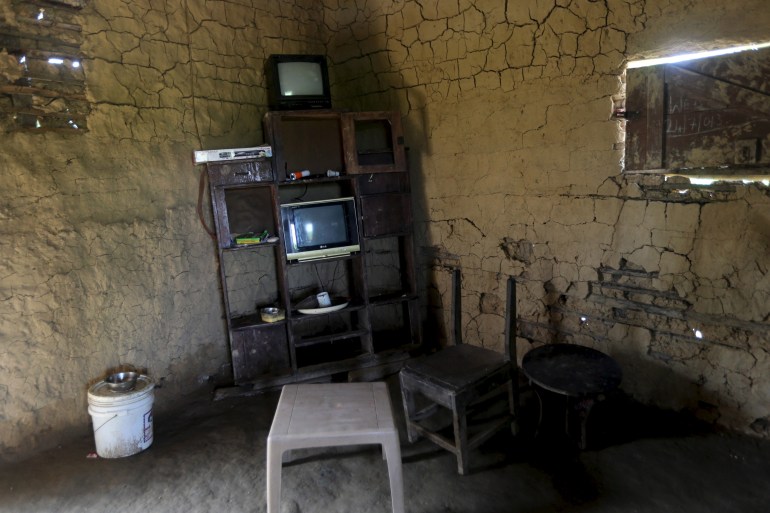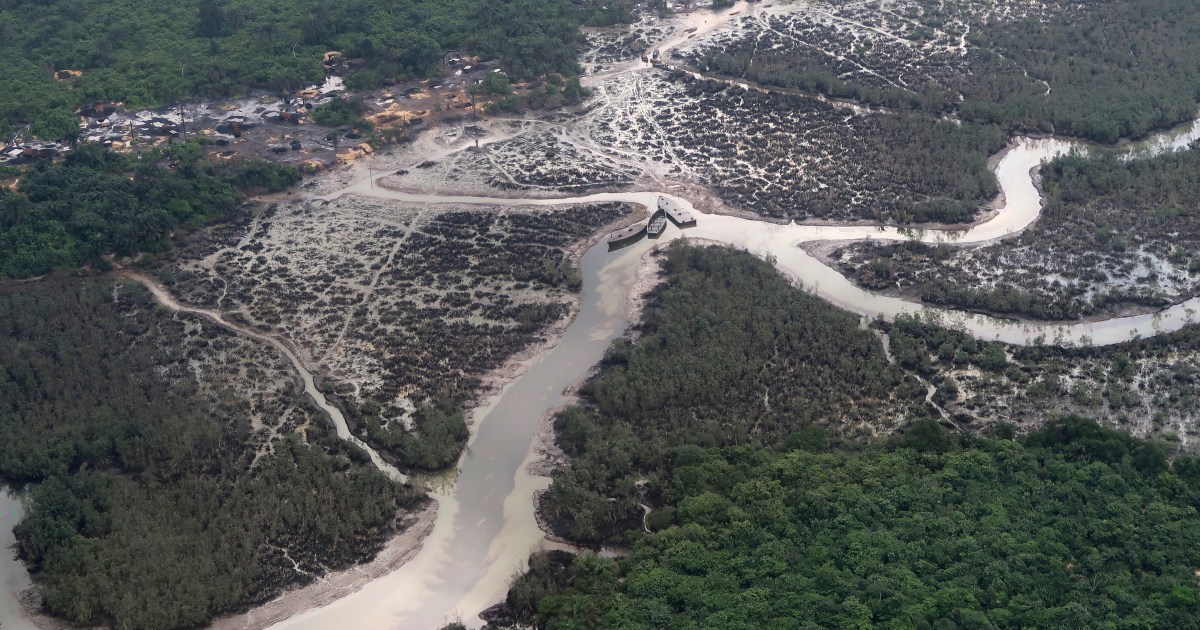In oil-rich Niger Delta, coastal erosion frustrates locals endlessly
Yenagoa, Nigeria – On a sweltering Friday afternoon last April, Kenneth Omokahire sat close to four neighbours outside his house in the Anibeze community in the southernmost Nigerian state of Bayelsa, lamenting to the men about coastal erosion in the town.
“What else can we do?” asked 65-year-old Omokahire, whose former house was completely submerged almost four decades ago. “This problem is not what we can solve as a community. We have [sought] for government’s help several times, but nothing has been done to save the community from the problem.”
On July 4, 1985, the four-bedroom apartment where Omokahire and his family used to live was washed away into the river. Now, they rent a smaller apartment in a nearby building with a leaky roof.
In Nigeria, coastal areas, which extend 853km through seven southern states bordering the Atlantic Ocean, are regularly affected by erosion, the loss of land caused by the removal of protective bedrock from the shoreline.
And the cost of this environmental phenomenon is huge.
In 2018 alone, the total cost of erosion in Nigeria’s states of Cross River, Delta and Lagos was estimated at $1.9bn or 1.6 percent of their combined gross domestic product (GDP), according to the World Bank.
Globally, the rise of sea levels due to climate change is increasing the risk of coastal erosion. According to a 2018 assessment by the United States National Aeronautics and Space Administration (NASA), sea levels could rise to 65cm (26 inches) by 2100, which could cause huge damage to coastal cities.
These are the outcomes of human-induced actions, natural environment changes and climate change, said Taiwo Ogunwumi, an environmental risk researcher at the United Nations University Institute for Environment and Human Security in Bonn, Germany.
‘All in vain’
In Bayelsa, one of six states in the oil-rich Niger Delta region of Africa’s largest oil producer, many of the people live in abject poverty despite years of oil exploration – and face environmental degradation, too.
The state is 90 percent water and has the longest coastline in the region, so residents often face the effects of human, but also natural, activity.
Some communities are situated on lands that are on average only 25m above sea level, so buildings regularly cave in across the state.
“In Obogoro [community], the river is now accommodating more water and the force in which the current is moving has increased so it is eating deep into the community,” Charles Oyibo, an environmental scientist and lecturer at the Niger Delta University on Wilberforce Island, told Al Jazeera.
“Then Anibeze community is domiciled on the culvert side of the riverbank, so naturally you expect things like this [coastal erosion] to happen,” he said. “So the threat is real and it has been there for decades.”
In Obogoro, the people, predominantly farmers, say they have lost about 60 percent of their homeland to coastal erosion. One of them, Somkieni Kpekpere, has lost two houses.
“I feel so sad because those [two] houses were built to help me remember my hard work,” the father of three said.
Even the place where he now stays with his family has developed cracks and he is worried about a repeat situation, especially as the house is near a river.
In Anibeze next to Obogoro, there is no longer power supply as one of the electric poles there has been washed away. Several houses and the community’s first primary school have met the same fate.
Until his graduation from that school in 1970, Omokahire walked daily to classes. But the impact of coastal erosion is forcing his children and their peers to go the extra mile by literally walking to school in neighbouring communities.
“In 2012, we calculated 250 buildings that were eroded,” 46-year-old Lucky Opuana, chairman of Anibeze’s community development committee, told Al Jazeera. “We have written letters to [both] state and federal government but all in vain. So, we appeal to the government and the whole world to help us before we lose the entire community.”
These days, the locals in both communities and elsewhere are piling pressure on the government to address the situation and mitigate further impact on their lives and the ecosystem.
In 2020, a “Save Obogoro Community” campaign was launched to advocate for long-term solutions to coastal erosion.
Members of the Anibeze community said they frequently use local media to seek government intervention. Opuana said environmentalists have also been invited from outside the community to tour the affected places and advocate for solutions to the problem of coastal erosion.
Their efforts so far have amounted to nothing, he said, but they have resolved to continue to try until the government responds.

An abandoned project
Experts say that as deforestation depletes the thick rainforests across the Niger Delta and causes the recession of the shoreline, more communities in the area will be exposed to coastal erosion. Urgent actions including sand filling and shoreline protection are needed, they say.
“One of the major solutions to address the issue of coastal erosion in Niger Delta is through mangrove restoration, which entails the planting of trees along the coastlines,” Ogunwumi said, adding that “mangrove restoration will serve as a buffer against extreme weather events [like] flooding [and] in the stabilisation of the coastline.”
To do this requires support from emergency institutions and government prioritisation because “a government that can borrow millions of naira to buy vehicles can equally borrow money for development purposes,” said Oyibo.
But that hasn’t come yet.
“The issue of coastal erosion has not been addressed by any administration since the creation of Bayelsa state [in 1996],” Alagoa Morris, a Yenagoa-based project officer with Environmental Rights Action/ Friends of the Earth Nigeria (ERA/FoEN), said. “There are several communities that need shoreline protection, but contracts have not been awarded by the state government.”
Morris claims his organisation made recommendations in 2018 to the government to establish a flood and erosion commission and collaborate with development partners both in Nigeria and abroad.
“But nothing [came of it],” he said. “Rather, when it happens to any community and you talk, a sitting governor will tell you my community is also facing the same problem.”
The Niger Delta Development Commission (NDDC) also reportedly awarded contracts for sand filling and shoreline protection in some communities, but the contractors abandoned the project.
Residents say NDDC, a government agency set up in 2000 to facilitate the development of the Niger Delta, has a long history of awarding multimillion-dollar contracts for projects but not completing them. Even the state government alleges that Bayelsa has the highest number of abandoned NDDC projects.
While they wait for government intervention, people are relocating to other areas, especially in neighbouring Delta state for safety.
But relocation is a luxury not everyone can afford. “We are in danger [especially] as we approach the rainy season,” Omokahire said. “For me, my house is close to the river and I fear the house will be affected. But I don’t have any other place to go.”




